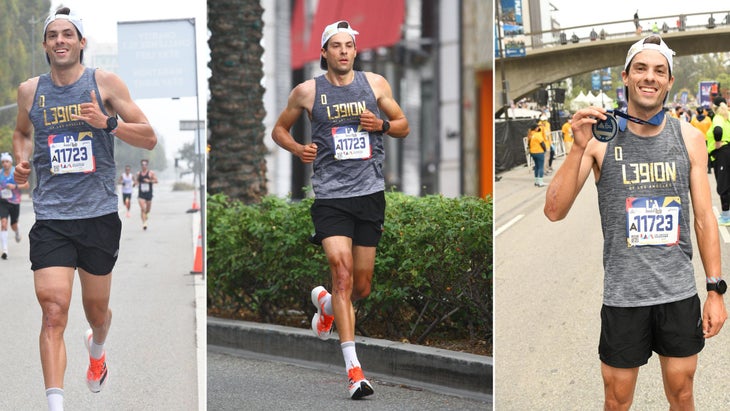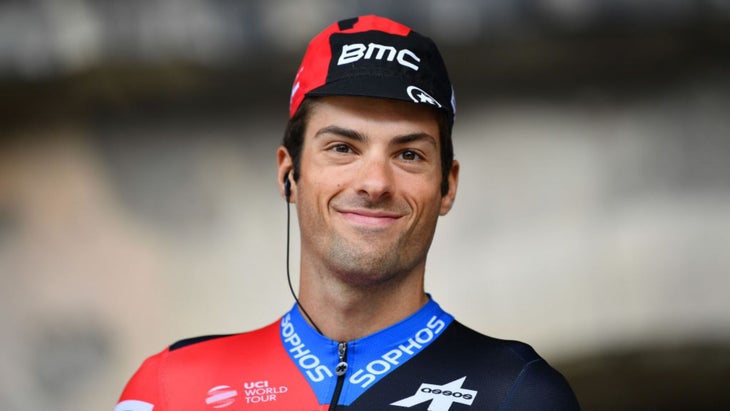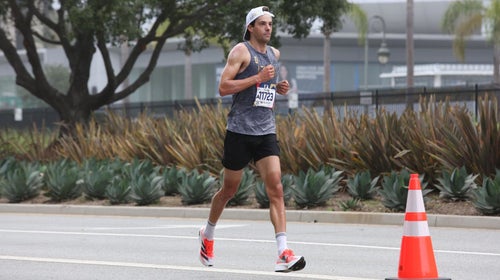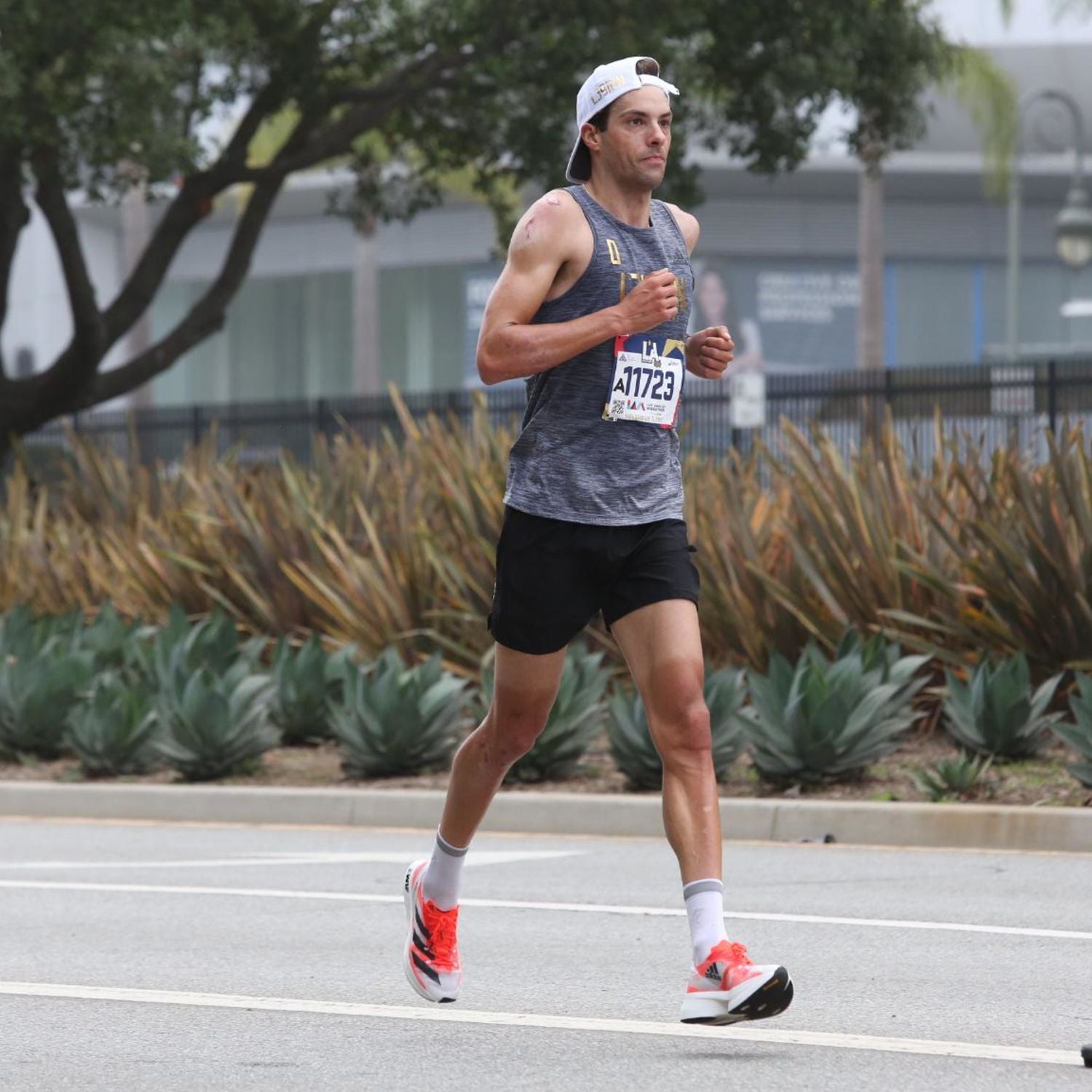As Eliud Kipchoge and a group of some of the world’s fastest runners assemble at the starting line for the Berlin Marathon on September 25, professional cyclist Freddy Ovett will lace up a pair of Adizero Adios Pro 2 racing shoes a few starting waves behind them and give it a go.
Ovett won’t be running with the lead groups and nor will he even be chasing an especially fast time goal. But as he progresses through the 26.2-mile course through the German capital, he’ll be an interesting case study for two reasons. Not only has the majority of his training has been done on a bike, but the lanky 6-foot-1, 140-pound athlete will also be following a refueling strategy based on real-time glucose monitoring with a newfangled mechanism that he’s used successfully as a cyclist this year.
“I’m not sure how fast I can run, to be honest,” he says. “I don’t really want to put a time on it because that’s not really the point of why I do it. I do it because I enjoy it, and I just like the mass participation part of things. But one of the things that cycling can do is build an incredible aerobic base, so it will be interesting to see how that translates over to running.”

A Pro Cyclist With a Curious Running Hobby
The 28-year-old Scottish-born Australian cyclist who lives most of the year in Dénia, Spain, is coming off his best year yet as a multi-discipline rider for the L39ion of Los Angeles UCI Continental team. While he typically trains on a bike almost every day, he’s also been making time to run one day a week this year with the goal of running a more consistent and potentially faster race in his second marathon.
Ovett is confident he’s fit enough to run better than he did last November at the Los Angeles Marathon, where he signed up on a whim three days before the race. How’d that experience go? Despite almost no run training, he still managed to average about 6:27 per mile and finished in a gutsy 2:48:55. Truth be told, he actually ran close to 6-minute pace (which would be a 2:37 marathon) until the 30 km mark (or 18.6 miles), where he backed off as muscular fatigue began to set in and his smooth, efficient form began to break down.
“I did LA off of no running, but it was pretty cool,” Ovett says. “I just thought it was so cool hanging out with people who have been preparing for something for so long and had set goals and you can see them getting after it. My old man didn’t agree with my plan, but he told me, ‘if you’re going to do it, when you’re in a place where you could potentially do damage, then slow it right down.’ And that’s what I did.”
His “old man” knows what he’s talking about. Freddy’s father, Steve Ovett, was a three-time Olympian for Great Britain and one of the greatest middle-distance runners in track and field history. Between the late-1970s to the mid-1980s, the elder Ovett set five world records at the 1,500-meter and mile distances, won a gold medal in the 800-meter run at the 1980 Olympics in Moscow, and garnered another in the 5,000-meter run at the 1986 Commonwealth Games in Edinburgh.
Freddy Ovett inherited a similar athletic skill set and ambitious drive that he used to win Australian junior national championships in both the 800 and cross country, as well as a junior Pan-Pacific 800 title. He was recruited to run for the hallowed University of Oregon track and cross country program in 2012 and spent his freshman year training in Eugene, Oregon, on an athletic scholarship.
But after a knee injury sidelined him from running, he left school, got into cycling and by 2015 had joined a French developmental team. Since then he’s progressed through three different teams before landing with L39ion of Los Angeles in 2021. He remains fully committed to cycling as his profession, but he’s also keenly interested as an athlete how much he can progress as a runner with once-a-year marathons as a benchmark.
View this post on Instagram
“My teammates totally think I’m nuts,” he says. “People in general can’t wrap their head around things that they can’t imagine themselves doing, and that’s what I’ve found with my teammates and other athletes. They ask, ‘Why are you running?’ and ‘Isn’t that impacting your cycling?’ and ‘Why are you trying to run so fast?’ People assume it’s performance-based, and yes, obviously I want to do that, but honestly I just enjoy running. And once you get to a certain level, running is just a beautiful thing that you can go out and do anywhere in the world if you just have a pair of running shoes.”
RELATED: The Surprisingly Simple Training of the World’s Fastest Marathoner
Can Training on a Bike Make You a Faster Marathoner?
Ovett isn’t the first pro cyclist to go down this road, but most have done it at the end or after their cycling careers.. Abraham Olano, who ran a 2:39:19 at the 2006 San Sebastian Marathon, is the leader in the clubhouse of cycling marathoners. But several others—Rolf Aldag (2:42:54, 2006 Hamburg Marathon), Laurent Jalabert (2:45:52, 2007 Barcelona Marathon), as well, of course, as Lance Armstrong (2:46:43, 2007 New York City Marathon)— have also run decent sub-elite times. Meanwhile, Australian Cameron Wurf is both a high-level pro cyclist for UCI World Team Ineo Grenadiers and also placed 18th at the 2021 Ironman World Championships held in St. George, Utah.
The biggest differences between aerobic training on the bike for running versus purely training on foot are that you can go almost limitlessly on a bike without the muscular breakdown and form fatigue that occurs during long runs, says Boulder, Colorado-based running coach David Roche. For those reasons, he’s an advocate of both out-of-season and in-season cross-training for runners, partially because other sports like cycling, weight training and certain forms of skiing can build complementary strength that can go a long way in supporting a runner’s fitness and form.
But being purely a bike-trained cyclist without any running background can begin to reshape how an athlete’s body functions and might take some deprogramming before a cyclist could achieve optimal marathon success, Roche said. In other words, most runners—especially recreational runners—must become accustomed to the neuromuscular responses brought on from pounding the pavement and race-paced running in order to run efficiently.
If you’re already a fast runner and then you become a cyclist on top of that, it’s much easier to become a great runner off that cycling,” Roche says. “If you’re more of a cyclist at baseline and never ran or developed your speed as a runner, the transition is going to be brutal.”
Ovett completely agrees about the need to maintain efficient running form and offset muscle breakdown as long as possible in a marathon. But he said a lot of that has to do with fueling, too. Optimal fueling keeps the mind and body at its best, he says, which combine to maintain optimal form, even as fatigue sets in.
As a cyclist, he said he’s spent a lot of time “training the gut” to accept 100-120g carbohydrate loads per hour during a long ride or race. But because refueling in a marathon is limited to taking a few gels and drinks from aid stations every few miles, he surmises that most marathon runners are typically woefully under-fueled for optimal performance in a marathon—and that includes his own experience in Los Angeles last fall.
Like a lot of sub-elite and recreational runners, Ovett admits he wasn’t precise enough about his fueling intake in that race, so, as his father feared, a late-race breakdown was inevitable once his glycogen stores had been depleted and his glucose levels dropped.
Ovett knows he’s never going to become an elite-level marathoner, but he’s aware that the keys to success are based mostly on a strong aerobic engine, optimal fueling and the ability to prolong efficient movement as long as possible. He knows he’s been blessed with good running mechanics, but he also knows his own improvement will be tied to how those three variables are interrelated.
“The reason that most cyclists can’t run is purely efficiency,” he says. “You can only go so far with poor running form. You will get found out sooner or later. But with cycling, you can get away with very poor form because it’s a non-impact activity. That’s why I highly recommend any form of non-impact exercises, even to professional marathoners. Your body doesn’t know if you’re running or cycling or swimming, it just knows it has to make the adaptation for the heart and lungs.”

An Upward Performance Trend in 2022
Ovett’s 2022 cycling highlights included a runner-up showing at the Zwift-based UCI Esports World Championships in February, winning the biggest climbing stage of the Redlands Bicycle Classic in Oak Glen, California, in April, and finishing second in the 142-mile SBT GRVL race in Steamboat Springs, Colorado, in mid-August. As a runner, he clocked a 14:41 effort at the Sant Silvestre de Girona 5K earlier this year.
He attributes a lot of his 2022 success to the two changes he made this year: running once a week and using the Supersapiens glucose monitoring system. (Supersapiens has been approved for use in Europe where it is not considered a medical device, but is not yet approved by the FDA in the U.S.) Those weekly workouts have ranged from 12 to 22-mile long runs to an occasional session of track intervals when it doesn’t interfere with his cycling. Meanwhile, the Supersapiens system has allowed him to keep track of his energy levels and manage his fueling needs in real-time, both while training and racing (in non-UCI events) and helping him keep tabs on his glucose levels during the course of an average day and retrospectively after a hard training block of difficult race.
It’s based on a technology that was originally developed for individuals with diabetes who constantly need to monitor glucose levels. The Supersapiens systems is geared toward helping athletes achieve optimal athletic performance through glucose stability while avoiding energy peaks and valleys.
In short, a small Abbott Libre Sense Glucose Sport Biosensor embedded into an individual’s skin sends glucose data via Bluetooth to the Supersapiens app on a smartphone, a wrist-based energy band or a Garmin watch. It can also give an athlete insights on how various types of food, supplements and sports drinks can impact his or her glucose metabolism.
Dr. Howard Zisser, Chief Scientific Officer for Supersapiens, points out that an athlete’s body and mind aren’t only fueled from glucose in the bloodstream, but also via sugars in the liver and the digestive tract, as well as fatty acids, ketones and lactates. He describes it like a complex Toyota Prius with different fuel sources coming from different tanks to optimally fuel different engines. Supersapiens is working on developing additional types of biosensors to address those complexities, but he believes monitoring glucose levels can be a significant first step for a cyclist, runner or triathlete.
“For endurance athletes in high-intensity, long-duration events, you don’t want to be in the basement. You want to be able to continually supply your body with fuel,” Zisser said. “The benefit of this is that you get a window into your glucose metabolism—what happens with food, stress, training, alcohol, travel, sleep and a multitude of things that influence your glucose metabolism.”
The Supersapiens app and energy band provide a glucose score based on the input Ovett has entered and gives him a precise understanding of his energy level and when he’ll need to refuel. It also gives alerts when there’s a steep change in glucose levels, and it offers the ability to review his blood data after hard workouts, long rides and, yes, his once-a-week runs.
“It’s pretty impressive,” Ovett says. “SuperSapiens is very particular to each individual because, as we know, everyone’s metabolism is running at a different rate. I have always had a super fast metabolism, so it’s been a game-changer for me, a really cool tool that has completely opened my eyes to what fueling well means. There are times when you’re on the bike you think you’re in a good place with fuel, but you really have no idea. I’ve been able to study myself with Supersapiens and hone my fueling to almost a perfect T almost.”
Ovettt credits the glucose alerts from helping him avoid bonking during the 200-mile UNBOUND Gravel race in Kansas back in May.
“That’s a 10-hour race,” he said. “Fueling well for that is the difference between finishing well and not finishing at all.”
He’s hoping to have the same takeaway in Berlin, even though it should only be a little more than 2 ½ hours. He knows if he continues to run 6-minute pace in a marathon, the last few miles are bound to get ugly.
“I am confident I will be able to somewhat enjoy those miles in a good painful way and not a bad painful way,” he said. “And I definitely know the difference.”


